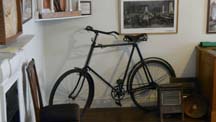Eternal Relevance
Bernard Shaw has something to say about nearly everything, and what he said remains relevant, even to medical professionals.
Molloy, E.J. The Doctor’s Dilemma: lessons from GB Shaw in a modern pandemic COVID-19. Pediatr Res (2020). https://doi.org/10.1038/s41390-020-0927-1
Shaw Performances During The Lockdown
Although many Shaw performances were cancelled in 2020, including those cherished ones at the Shaw Festival, one can still have the Shaw experience online.
Pandemic Players Present Saint Joan, March 21, 2020
You can watch the whole play here. This is a live-stream by 24 performers and the creative team, all working from home, in support of the community theatres in the Baltimore area.
Buoyant Billions presented at the International Shaw Symposium, July 25, 2020
A one-act adaptation of a very late Shaw play, Buoyant’s Billions (1947) was presented by the Not Ready for Prime Time Players, the International Shaw Society Performing Arts Troupe. The play was adapted by Christopher Wixson.
Gingold Theatrical Group presented many live streams
Rehearsals at the Shaw Festival continues, though the Shaw productions were eventually cancelled.
Shaw Online
Here are the invaluable tour of Shaw’s Corner and other Shavian conversations, presented by Professor Stanley Weintraub: https://shaw-institute.com/welcome/weintraub/. Many thanks to Dr. Anne Wright CBE for drawing attention to this in her Tribute to Professor Weintraub in A Writing Life, by Stanley Weintraub, Eds. Michel Pharand and David Weintraub, ELT Press, 2020.
Works by Professor Stanley Weintraub, presented by the Shaw Bot: https://sagittarius.apps01.yorku.ca/weintraub/
Contingency Measures to Re-open Theatres
How did theatre companies do risk management? Theatres face an uncertain future, but there may still be hope.
- Insurance policy: Shaw Festival
Shaw Festival Executive Director and CEO Tim Jennings is super-smart to have a pandemic insurance in place
2. Fewer seats for social distancing: Berliner Ensemble Theatre
Iconic Berlin theater looks very different with seats removed for social distancing
3. Drive in Theatres
Ontario to allow drive-in theatres and batting cages amid pandemic
4. Socially distanced seats and face masks
Fewer seats and more spaced out rows
Here’s what Ottawa moviegoers can expect as theatres reopen this weekend
5. Staggered movie starts and auditorium exiting. The number of entrances and exits to the theater and open restrooms are also limited.
Kawartha theatres cautiously weigh benefit of reopening during pandemic
6. Socially distanced performances
Now only is social distancing practised in seating arrangements, the cast have to practise social distancing too, like standing on individual platforms distanced from one another. e.g. Parker Theatre (formerly the Utah Children’s Theatre) in Salt Lake City.
Live Theater Is Changing in Creative Ways During Pandemic
7. Digital drama delivered virtually
This can be creative, inviting the audience to participate including improvisations, radio drama, virtual play reading.
Performing Original Works in a Pandemic, Artists Turn to New Tools
8. Infrared camera to take temperatures at the stage door with airlock — Lloyd Webber Theatre, UK
9. Cinema-goers in face masks, staff wearing perspex visors or masks
10. Deep clean of the auditorium after each screeningclean ‘high-touch areas’ frequently:
“surfaces and touch screens at ticket kiosks have to be wiped every 15 minutes, and door handles and toilets every 30 minutes. They even have to wash their hands every single time they handle paper money.”
11. Lining up: One-way systems and floor plans telling people where to stand
12. Social distancing in auditorium-groups standing apart from one another
13. Tickets shown on smart phones
14. Cinema goers complete a test and trace form
15. Hand sanitizers for cinema goers
Future engineering necessities
Will these lead to future engineering necessities and a next generation of theatres? Just have a look at what experts predicted.
- Larger lobbies with sanitizing stations in the lobby, around the box office, at the bar, and in line for the restrooms
2. Larger auditorium seating to accommodate social distancing





